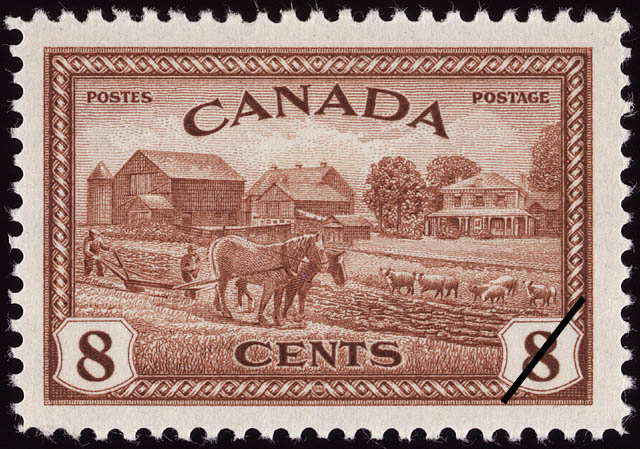Canada has been named the winner of the inaugural Stamp Madness contest after earning nearly 60 per cent of the popular vote in the final round of the bracket-style tournament held by the American Philatelic Society (APS).
Affectionately dubbed the “Stampionship,” the contest’s final round paired stamps from two 1946 Peace issues—Canada’s eight-cent Eastern Farm stamp (Scott #268), and New Zealand’s nine-cent Southern Alps and Chapel stamp. Canada won 59 per cent of the vote in the fourth and final round of the balloting, which concluded on April 10 at midnight.
The APS also announced in celebration of Canada’s upcoming sesquicentennial, the July edition of The American Philatelist “will be dedicated to Canada with special articles about Canadian philately.”
PRIZES
Prizes were rewarded via random draws throughout the contest.
John Perquin, of Pennsylvania, was chosen as the grand prize winner of a 2005 U.S. Postal Service Yearbook, which includes $51.43 in face-value stamps.
Jerry Derr, of Colorado, was among those who voted for Canada in the championship round. His name was chosen to win a The Civil War (1994) commemorative stamp book from the U.S. Postal Service.
Two contestants—one from the preview and one from the championship—were selected to win copies of the APS-published book, Cataloging U.S. Commemorative Stamps: 1950, by Charles Posner. One of these winners, Blair Stannard, of Ontario, is an honorary life member of The Royal Philatelic Society of Canada. The other winner was John Murphy, of New York.
PEACE STAMPS
The stamp’s image was engraved by Warrell Hauck, whose work is seen on a number of Canadian stamps and at least one Canadian banknote, the 1954 Canadian Landscape Series issued by the Bank of Canada.
The stamp was designed by Herman Herbert Schwartz, who’s also remembered for designing the famed 50-cent Bluenose stamp (SC #158) issued on Jan. 8, 1929. Schwartz’s work can be seen on many of the stamps issued by the Post Office Department from 1927 through the mid 1950s.

Canada’s Eastern Farm stamp was paired against New Zealand’s nine-cent stamp ‘A Spirit of Thankfulness’ (shown above), which was also part of a peace-themed series.
The design of the Eastern Farm stamp is based on a photograph by L.W. White, an early Canadian photographer; however, according to the 1964 book Canada’s Postage Stamps, the scene is actually a composite from four photographs. While the image of the farm house to the right is from a photograph taken in Eastern Ontario, the barn to the left is from a photograph taken in Western Ontario; the silo is from another photograph taken in Central Ontario; and the ploughmen and horses are from a fourth photograph taken in Quebec.
New Zealand’s stamp was issued as part of its postal service’s Peace and Victory series, which was an 11-stamp set produced by Bradbury Wilkinson. The series’ nine-cent stamp—titled “A Spirit of Thankfulness”—defeated a Swiss stamp in the first round, after which time it managed what organizers are calling a “somewhat stunning victory over the pre-tournament favourite,” the 1962 Project Mercury stamp issued by the U.S. In another close matchup, New Zealand narrowly defeated Laos’ 1958 Elephants stamp.
CANADA’S JOURNEY TO THE FINAL FOUR
The original 16 stamps represented four regions, including the Americas, Europe, the Pacific, and Afro-India. All stamps from the regions of Europe and Afro-India were eliminated during the second round, and only stamps from the Americas and the Pacific remain.
In the third round, Canada’s 1946 Eastern Farm stamp defeated the 1964 World’s Fair stamp issued by the U.S. In the second round, Canada topped India’s 1949 Taj Mahal stamp, and in the opening round, we bested Chad’s 1964 Potter stamp.
CHOOSING 16 STAMPS
According to the APS, several guidelines were used in choosing the original 16 stamps for the contest.
These guidelines included:
• featuring only standard postage stamps (no airmail, express mail, revenue stamps, etc.);
• using no specific images of individuals (kings, queens, scientists, musicians, etc.);
• avoiding the use of “masterwork” paintings and photos (although statuary and buildings were allowed);
• attempting to capture diverse designs, colours, topics, and countries (although only independent countries, no colonies, were allowed);
• using only common stamps and no rarities; and
• using stamps from after the Second World War through 1970.

